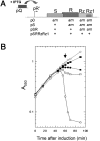Micron-scale holes terminate the phage infection cycle
- PMID: 20080651
- PMCID: PMC2836697
- DOI: 10.1073/pnas.0914030107
Micron-scale holes terminate the phage infection cycle
Abstract
Holins are small phage-encoded proteins that accumulate harmlessly in the cytoplasmic membrane during the infection cycle until suddenly, at an allele-specific time, triggering to form lethal lesions, or "holes." In the phages lambda and T4, the holes have been shown to be large enough to allow release of prefolded active endolysin from the cytoplasm, which results in destruction of the cell wall, followed by lysis within seconds. Here, the holes caused by S105, the lambda-holin, have been captured in vivo by cryo-EM. Surprisingly, the scale of the holes is at least an order of magnitude greater than any previously described membrane channel, with an average diameter of 340 nm and some exceeding 1 microm. Most cells exhibit only one hole, randomly positioned in the membrane, irrespective of its size. Moreover, on coexpression of holin and endolysin, the degradation of the cell wall leads to spherically shaped cells and a collapsed inner membrane sac. To obtain a 3D view of the hole by cryo-electron tomography, we needed to reduce the average size of the cells significantly. By taking advantage of the coupling of bacterial cell size and growth rate, we achieved an 80% reduction in cell mass by shifting to succinate minimal medium for inductions of the S105 gene. Cryotomographic analysis of the holes revealed that they were irregular in shape and showed no evidence of membrane invagination. The unexpected scale of these holes has implications for models of holin function.
Conflict of interest statement
The authors declare no conflict of interest.
Figures




Similar articles
-
Stable micron-scale holes are a general feature of canonical holins.Mol Microbiol. 2014 Jan;91(1):57-65. doi: 10.1111/mmi.12439. Epub 2013 Nov 21. Mol Microbiol. 2014. PMID: 24164554 Free PMC article.
-
Probing the structure of the S105 hole.J Bacteriol. 2014 Nov;196(21):3683-9. doi: 10.1128/JB.01673-14. Epub 2014 Aug 4. J Bacteriol. 2014. PMID: 25092029 Free PMC article.
-
Membrane fusion during phage lysis.Proc Natl Acad Sci U S A. 2015 Apr 28;112(17):5497-502. doi: 10.1073/pnas.1420588112. Epub 2015 Apr 13. Proc Natl Acad Sci U S A. 2015. PMID: 25870259 Free PMC article.
-
[Current advance in the topological structure and function of holin encoded by bacteriophage lambda--a review].Wei Sheng Wu Xue Bao. 2012 Feb 4;52(2):141-5. Wei Sheng Wu Xue Bao. 2012. PMID: 22586990 Review. Chinese.
-
Holin of bacteriophage lambda: structural insights into a membrane lesion.Mol Microbiol. 2008 Aug;69(4):781-3. doi: 10.1111/j.1365-2958.2008.06335.x. Epub 2008 Jun 28. Mol Microbiol. 2008. PMID: 18573181 Review.
Cited by
-
Bursting out: linking changes in nanotopography and biomechanical properties of biofilm-forming Escherichia coli to the T4 lytic cycle.NPJ Biofilms Microbiomes. 2021 Mar 17;7(1):26. doi: 10.1038/s41522-021-00195-7. NPJ Biofilms Microbiomes. 2021. PMID: 33731698 Free PMC article.
-
Bacteriophage Proteome: Insights and Potentials of an Alternate to Antibiotics.Infect Dis Ther. 2021 Sep;10(3):1171-1193. doi: 10.1007/s40121-021-00446-2. Epub 2021 Jun 25. Infect Dis Ther. 2021. PMID: 34170506 Free PMC article. Review.
-
Active Bax and Bak are functional holins.Genes Dev. 2011 Nov 1;25(21):2278-90. doi: 10.1101/gad.171645.111. Epub 2011 Oct 17. Genes Dev. 2011. PMID: 22006182 Free PMC article.
-
Phage lysis: three steps, three choices, one outcome.J Microbiol. 2014 Mar;52(3):243-58. doi: 10.1007/s12275-014-4087-z. Epub 2014 Mar 1. J Microbiol. 2014. PMID: 24585055 Free PMC article. Review.
-
Active S2168 and inactive S21IRS pinholin interact differently with the lipid bilayer: A 31P and 2H solid state NMR study.Biochim Biophys Acta Biomembr. 2020 Jul 1;1862(7):183257. doi: 10.1016/j.bbamem.2020.183257. Epub 2020 Mar 5. Biochim Biophys Acta Biomembr. 2020. PMID: 32147355 Free PMC article.
References
-
- Young R, Wang IN. Phage lysis. In: Calendar R, editor. The Bacteriophages. 2nd Ed. New York: Oxford Univ Press; 2006. pp. 104–128.
-
- Wang IN, Smith DL, Young R. Holins: The protein clocks of bacteriophage infections. Annu Rev Microbiol. 2000;54:799–825. - PubMed
-
- Gründling A, Bläsi U, Young R. Biochemical and genetic evidence for three transmembrane domains in the class I holin, lambda S. J Biol Chem. 2000;275:769–776. - PubMed
-
- Summer EJ, et al. Rz/Rz1 lysis gene equivalents in phages of Gram-negative hosts. J Mol Biol. 2007;373:1098–1112. - PubMed
Publication types
MeSH terms
Substances
Grants and funding
LinkOut - more resources
Full Text Sources
Other Literature Sources

